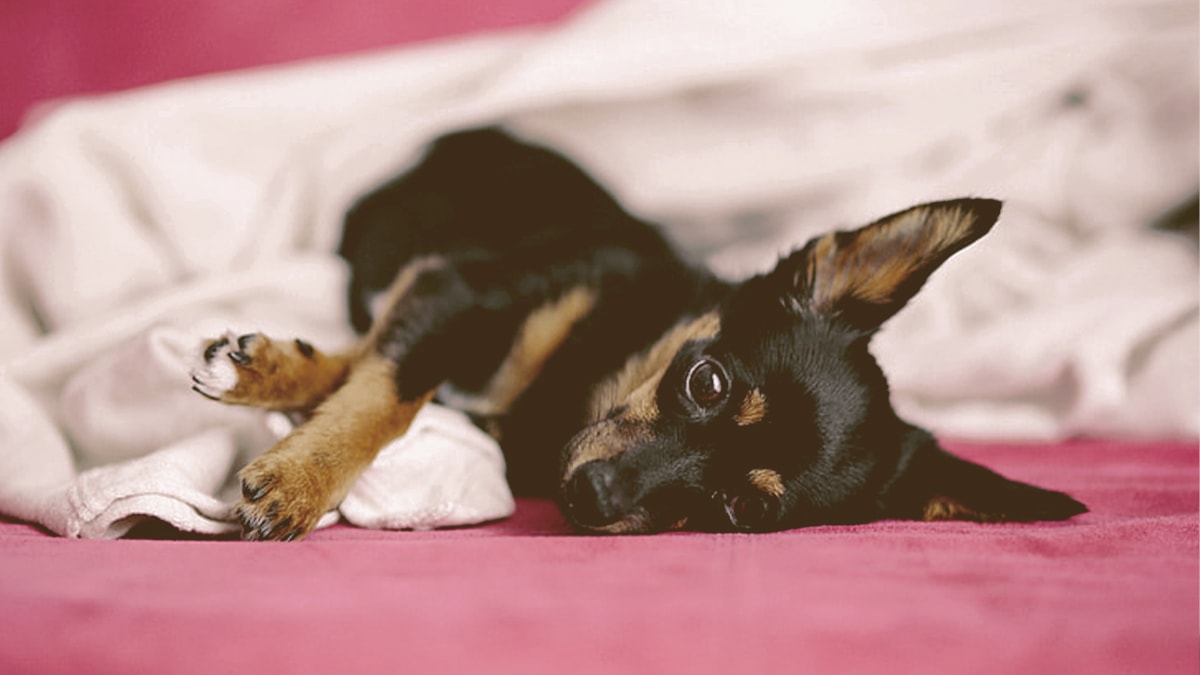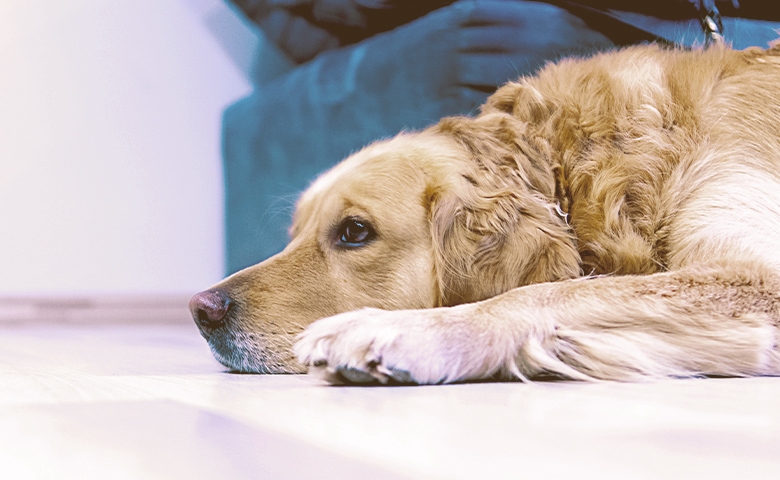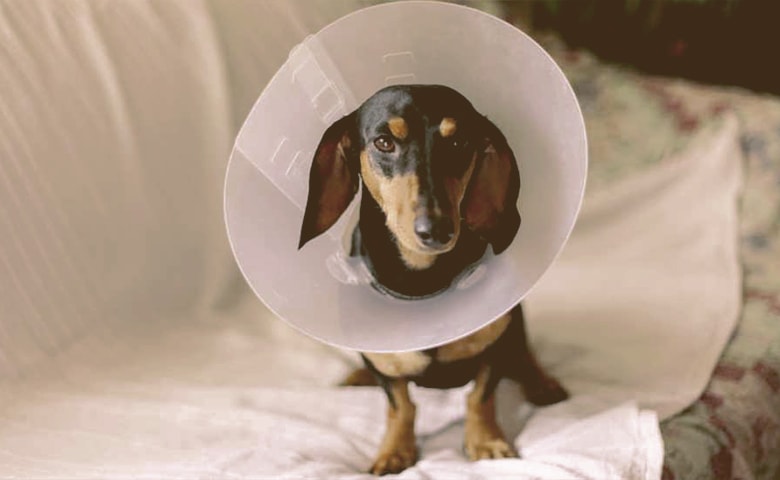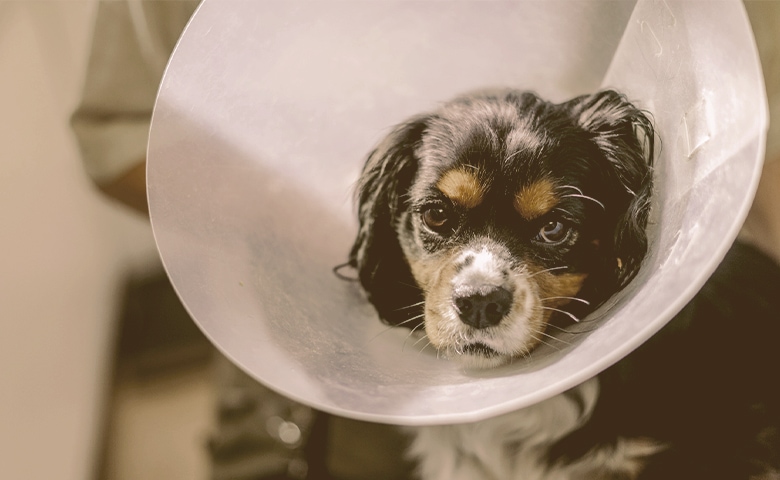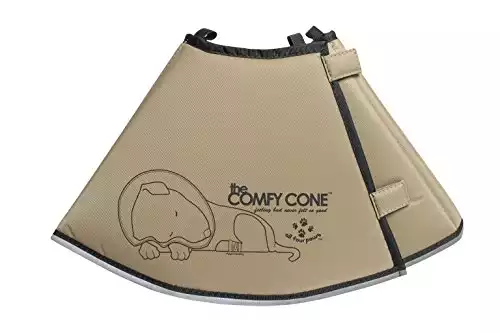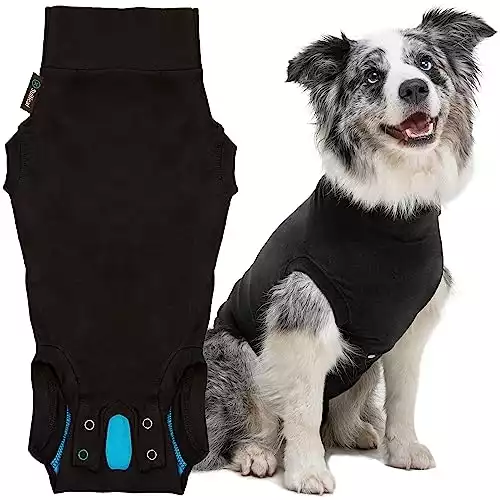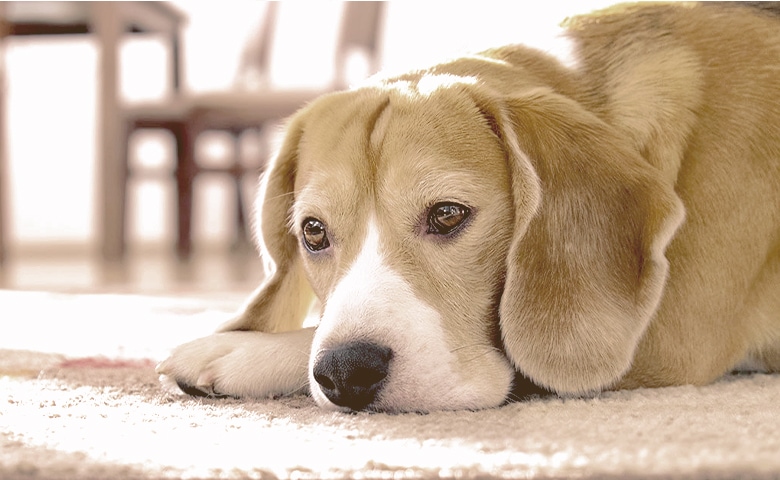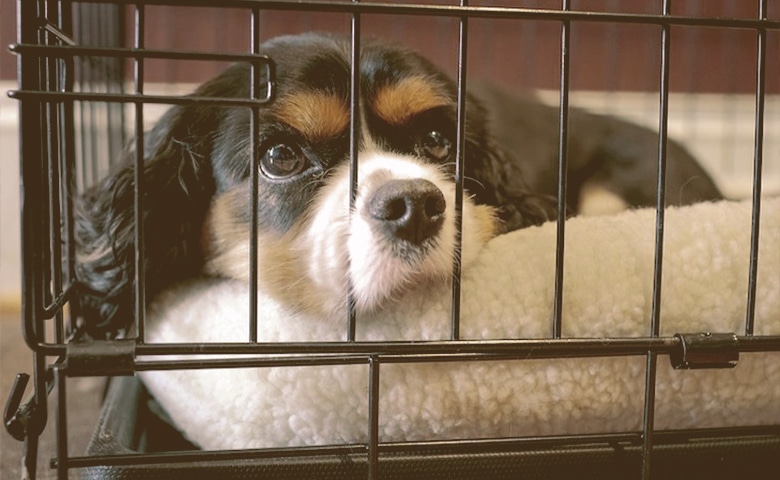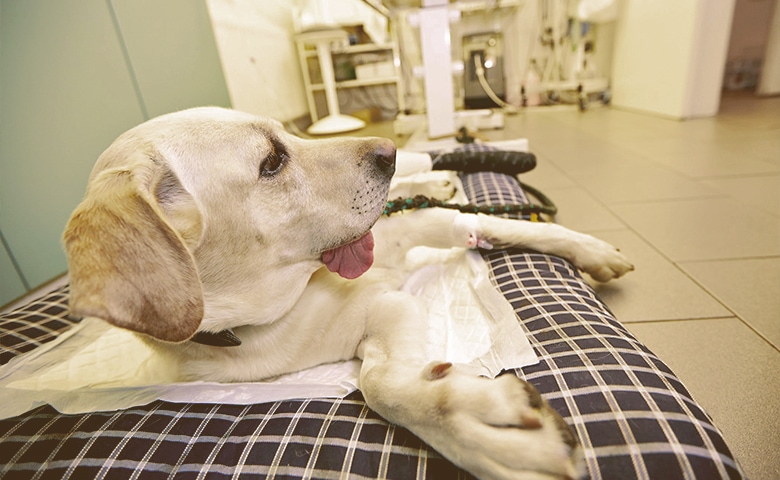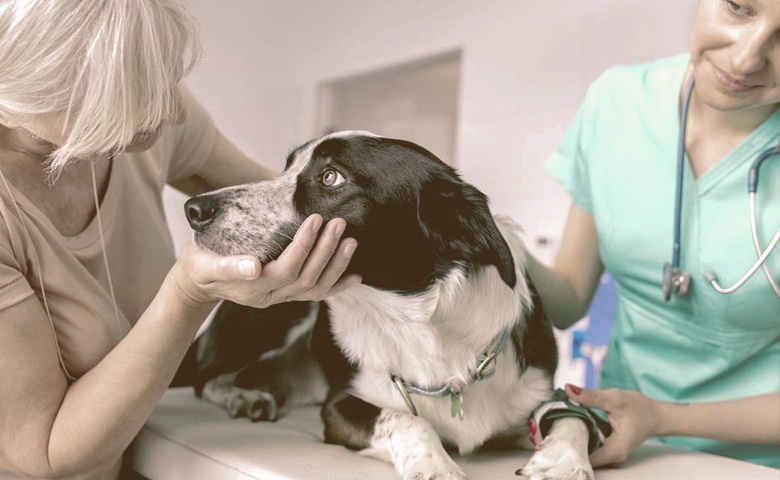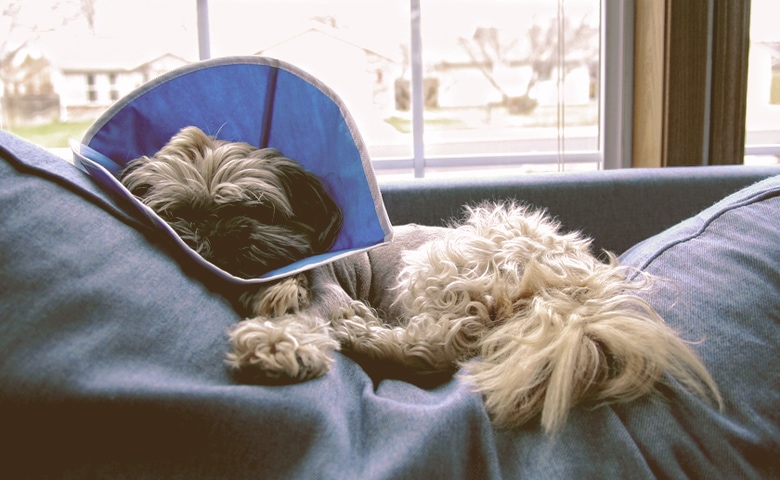How to Keep Your Dog From Licking a Spay Incision
Alex Vicente • Updated on August 17, 2023
- This review contains affiliate links. Read more here.
- Not a substitute for professional veterinary help.
After getting your dog spayed, keeping them from licking the spay incision is one of your most important tasks when it comes to keeping the wound clean. Some dogs can obsessively lick their stitches to the point that they cause damage to the incision site or even open the wound back up.
Elizabethan collars are probably the most famous way to keep a dog from licking a spay incision, but they aren’t the only method available. Read on to learn more about the different ways you can help protect a spay incision after your dog has surgery.
Table of Contents
How to Keep a Dog From Licking a Wound
When it comes to keeping a dog from licking a wound, there are two major ways you can go about it. You can either use something to cover up the spay incision site so the dog doesn’t have access to it to lick at it, or you can smear a bad-tasting substance around the incision so that the dog won’t want to lick it.
When figuring out how to keep your dog from licking a spay incision, you need to keep two things in mind. Whatever method you choose needs to allow air circulation around the incision site to keep the wound clean, and it also needs to allow good blood circulation to the wound so that it can continue to heal.
You should also remember that if you use a substance around the spay incision to deter licking, you should never put any anti-chewing substance directly on the incision site. These substances are meant for topical (surface) use and shouldn’t come into contact with open wounds on your dog. Some dogs may also be less affected by anti-chewing deterrents than others.
Why You Should Keep Dogs From Licking Incisions?
If a dog’s natural instinct is to lick at its wounds, then why would people want to stop them from doing it? Dogs naturally lick their wounds because dog saliva contains a few different chemicals that can help a dog deal with its wounds in the wild. Here are some of the ways that dog saliva can help a dog with an injury:
- Dog saliva is antibacterial and antimicrobial. Dog saliva has been shown to have antibacterial properties that can help protect them from some secondary infections.
- Dog saliva contains a natural pain reliever known as opiorphin. This painkiller helps the dog feel better, which is one of the reasons licking its wounds is such a self-soothing activity for them.
- Licking helps clean the wound. In an open wound, a dog’s licking would help remove any external debris that ended up in the cut to reduce the chance of secondary infections. However, this is unnecessary in a surgically sterilized spay incision.
- Licking helps relieve itching. A healing wound will often itch deeply as the tissues knit themselves back together, and the only way the dog can gently scratch itself is by using its tongue.
Even though dog saliva provides many benefits for wild or feral dogs, the antibiotics and painkillers given to dogs after their spay surgeries are much more effective than the mild antibacterial and painkilling properties present in the dog’s saliva.
The other major reason that you should keep dogs from licking their spay incision is that when they encounter the stitches in their wound, many dogs may feel the urge to rip the stitches loose or rip them out completely.
If licking of the spay incision site is left unchecked, this can potentially lead to the dog opening their wound back up. For an abdominal surgery like a spay incision, the threat of outside infection in the abdomen from a reopened incision is a dangerous one.
Is Dog Saliva Safe for Spay Incisions?
While dog saliva might have some mild antibacterial and antimicrobial properties, it is also full of other types of bacteria that can lead to serious wound infections. Most veterinarians would consider even a few licks to the incision site to be a risk not worth taking.
Tools for Protecting Spay Incisions
Luckily for dog owners who need to keep their dog’s teeth and tongue away from their spay incisions, there are plenty of tools available that can help prevent the dog from accessing their surgery site. Here are a few of the different methods you can use to help protect your dog’s wound after spay surgery.
Recovery Suit
A recovery suit is a full-body bandage that fits the dog from the neck across the entire torso, leaving holes for the legs and the tail. These suits are a good option for dogs that are stubborn about keeping on anti-chewing collars. Along with being used for post-spay recovery, these suits can be used to help with various other issues such as hot spots or skin allergies.
Tee-shirt
For a cheaper version of a recovery suit, you can put a baggy tee-shirt on your dog. To keep the tee-shirt on the dog, You’ll need to tie a knot in the bottom of the shirt to fit it to the dog’s form, then use tape (on the shirt, not the dog!) to secure the tee-shirt in place.
While this option doesn’t cost as much as a recovery suit, it’s a little more labor-intensive and the dog may try to pull it off. The shirt may also get blood or other fluids on it if the wound begins to seep.
Elizabethan Collar
Elizabethan collars, commonly known as the “cone of shame” for the embarrassed looks that some dogs will have when they’re forced to wear them, are one of the most popularly prescribed tools for post-surgery wound protection. These wide collars prevent the dog from being able to reach its body to lick.
Good Elizabethan collars are padded for the dog’s comfort and are easy to attach on and off so that the collar can be removed easily. You can usually take them off when the dog is asleep, but be mindful and consult your vet before doing so.
Anti-Chewing Sprays
If you want to try and control your dog’s licking without covering up the spay incision, bitter anti-chewing sprays are a good option.
Bitter anti-chewing sprays like Grannick’s Bitter Apple are a chemical created from sour apple or orange that cause the flesh around the spay incision to taste bad to the dog. For many dogs, this is enough of a deterrent to keep the dog from licking the spot.
The only downside to bitters is that some dogs are so compelled to lick that they’ll lick no matter how bad the incision site tastes. For dogs that are this persistent, more advanced measures such as an Elizabethan collar or a recovery suit have to be taken instead.
The advantage of buying bitters to protect a surgery site is that these nasty-tasting bitters can be used with your household pets for other things. For example, you can prevent your dog or cat from chewing on electrical wires by coating the wires with anti-chewing spray.
Onesies
Onesies aren’t a good option for larger dogs, but for small breed dogs a child’s onesie can work as a cheaper alternative for a recovery suit. The advantage of using a onesie is that they often come with an easy snap-on design that makes it simple to take the dog in and out of it.
Inflatable Collars
Inflatable collars are similar in design to Elizabethan collars except that instead of using flat panels to form the sides of the collar, the collar is formed from a blow-up ring instead. While inflatable collars can be as effective as Elizabethan collars when it comes to keeping a dog from licking a spay incision, they aren’t a good choice for dogs who will try to claw them off.
Deodorant
If you’re in a pinch and you don’t have anything else to keep your dog from licking their spay incision, rubbing a stick of strong-smelling deodorant around the incision (not on it) can deter many dogs from licking the site. Deodorant can be toxic to dogs if licked in large quantities, so don’t continue to use this method if the dog ignores the deodorant and licks the site anyway.
How to Choose an Anti-Licking Tool for Post-Surgery
The type of tool you employ with your dog to help keep their incision site clean after their spay surgery will depend on a few different factors. Here are some of the things you should look at when deciding what kind of method you should use to keep your dog from licking a spay incision:
- What is your dog’s body shape? Some dogs with long necks such as greyhounds may find it difficult to wear a traditional Elizabethan collar effectively.
- What is your budget like? Some anti-chewing options like a recovery suit can be somewhat expensive, while you might find some materials for a cheaper method like the tee-shirt method lying around the house.
- How much is your dog licking? Some dogs may not feel the urge to lick their spay incision and may not require anti-licking measures, while others may have a serious problem with it up to the point of ripping out their stitches. Observe your dog carefully after surgery to determine whether they need post-surgical protection.
Even if you don’t think your dog will lick their spay incision after surgery, it’s a good idea to have a plan in place in case you catch the behavior. You don’t want to have to run out looking for an Elizabethan collar at the last minute.
How to Help Spay Incisions Heal
Keeping your dog from licking their spay incision is an important part of helping prevent infection at the incision, but it’s not the only thing you can do to help your dog heal after their spay surgery. Here are a few other things you can do to help your dog heal after they get spayed:
- Keep the dog in a crate. This may be stressful for the dog if they’re an active dog or they aren’t used to crate-training in general, but it’s the safest way to prevent your dog from developing complications after the spay related to excess exercise or exposure to bacteria in the environment.
- Keep the dog medicated. If your dog was sent home with medications such as pain relieving medication or antibiotics to prevent infection, make sure to give your dog their post-spay medications as directed. It’s especially important with antibiotics to finish out the entire prescription even if your dog shows no sign of infection.
- Don’t let the dog go swimming. It might be hard to keep water-loving dogs out of the pool or lake, but immersion in water can greatly increase the chance of a secondary post-surgical infection.
- Bring your dog back to the vet for a check-up. Veterinarians will request that you bring your dog back to the vet a few weeks after their spay surgery so that the incision can be checked for complications or infection. Depending on the surgery, the vet may also need to remove a surgical drainage stent.
- Make sure your dog rests. Some dogs may bounce back from a spay surgery quickly, but they also run the risk of injuring themselves if they try to get back to their high-intensity activities such as running and jumping too soon after their spay. Make sure that even active dogs rest after surgery by confining them.
- Return to normal feeding gradually. To prevent stomach upset and throwing up that might strain the surgical site, withhold food for four hours after surgery and introduce food gradually back over the next twenty-four hours.
If you take just a few steps to make sure that your dog’s post-surgical recovery goes well, you can go a long way toward preventing infection and potentially taking on additional veterinary bills to deal with surgical complications.
How Long Does Spay Recovery Take?
In general, it takes a dog around fourteen days (or two weeks) to recover from a spay surgery. This time may be lengthened if the dog had complications during spay surgery or had to have an especially large incision.
Why Do Dogs Develop Infection After Surgery?
There are several theories in veterinary medicine for why some dogs might be more at risk for infection after a spay surgery than others. Here are just a few of the reasons that veterinary scientists have looked at when it comes to post-spay infections:
- Hyperglycemia: Hyperglycemia (or high blood sugar) during surgery has been associated with a higher risk of infection post-surgery. This is one of many reasons why veterinarians direct that animals and humans undergo a fast prior to surgery.
- Self-mutilation: Licking and chewing at an incision site increases the chance of post-surgical infection. This is the main reason why anti-licking tools are used to keep a dog from licking a spay incision.
- Anti-inflammatory drugs: While anti-inflammatory drugs can help alleviate any abdominal swelling associated with surgery, they can also suppress the dog’s immune system. This can lead to post-surgical infection.
While a dog owner might not be able to control whether their dog is prescribed anti-inflammatory drugs or not, they can help reduce the other risks of post-surgical infection by not feeding their dog before surgery and by keeping their dog from licking the spay incision afterwards.
What Happens If Your Dog’s Spay Becomes Infected?
Even if you do your best to keep your dog’s spay incision clean and healthy, sometimes infection still happens. Here are some of the signs to look out for to determine whether your dog has developed an infection at their spay incision:
- Weeping wound: While some weeping from the surgery site is normal as the incision heals, a wound that weeps more than a few drops of fluid is a sign of pus and infection inside the incision.
- Heat and inflammation: Some inflammation is normal right after surgery, but this inflammation should subside quickly as the wound begins to heal. If the wound remains puffy and red-looking or feels hot to the touch, it should be examined by a vet.
- Bad smell: A foul smell coming from the spay incision can be a sign of a bacterial infection.
If you see any signs of potential infection at your dog’s spay incision, don’t wait to alert your vet. Make an appointment to have the incision site checked to see if the dog needs to be prescribed further antibiotics or they need the incision site drained. You don’t want to wait around on an abdominal infection since it can lead to more serious medical complications.
Keep Your Dog From Licking Their Incision
Even though it might seem like a bit of a hassle, it’s worth it to try and keep your dog from licking their spay incision. This can help your dog heal faster and keep them more comfortable, but it can also help prevent life-threatening infections after their surgery.

